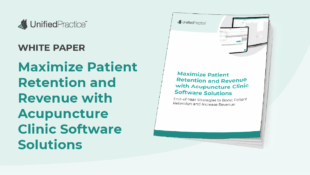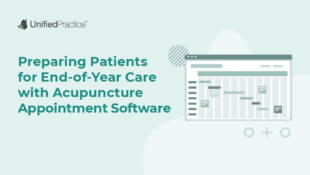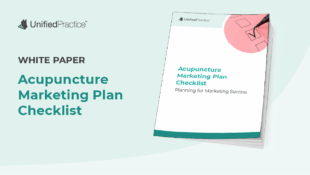Michelle Grasek, MS, L.Ac., is a practicing acupuncturist, marketing strategist, and founder of Acupuncture Marketing School. She’s been teaching marketing for seven years and has taught marketing to over 2,500 acupuncturists. It’s her mission to help acupuncturists grow their business through authentic marketing techniques. The team at Unified Practice invited Michelle to share her top three insights about social media mistakes, and how to fix them.
Top 10 Acupuncture KPI Metrics
1: Client Satisfaction
Client satisfaction is a direct reflection of how well your practice meets patient expectations. High satisfaction rates often translate into repeat business, positive reviews, and referrals. This metric can be measured through patient surveys, feedback forms, and online reviews. Collect feedback on various aspects like treatment effectiveness, staff demeanor, and the clinic environment. For your goal post, aim for a satisfaction rate of at least 85%, which is a common benchmark in the healthcare industry. Overall, regularly reviewing this data helps you identify areas for improvement and celebrate what you’re doing right.
**Happy clients are much more likely to become loyal patients, so it’s best to make this KPI metric a priority.
2: Client Acquisition
This KPI metric helps you understand where your new patients are coming from and whether your marketing efforts are effective. Using tools like Unified Practice’s software, you can generate Patient Demographics Reports that provide insights into your patient base, including age, gender, and geographic location. In addition, Referral Sources Reports can help you identify how patients found your clinic, whether through word-of-mouth, online searches, or marketing campaigns. To calculate client acquisition, track the number of new clients over a specific period. Benchmarks vary, but a monthly growth rate of 5-10% is a good target.
3: Client Retention
Client retention measures how well you keep existing patients coming back for treatments. A high retention rate suggests that your patients are satisfied and find value in your services. You can track this using the Patient Retention Report in Unified Practice’s software, which distinguishes between returning and new patients. How can you do this? Calculate retention by dividing the number of returning patients by the number of total patients. An industry goal for retention rates is around 70-80%.
4: Revenue per Month
Revenue per month is a straightforward yet essential metric. It tracks the total income generated by your practice each month. This KPI helps you understand your business’s financial health and identify trends over time. Calculate this by summing up all revenue streams, including treatments, product sales, and consultations. Aim for steady growth month over month to ensure your practice remains financially viable.
5: Revenue per Client
Revenue per client is a KPI metric measuring the average income generated from each patient. This metric helps identify the financial value of your services and can highlight opportunities for upselling or introducing new services. To see where you stand, divide the total revenue by the number of clients within a specific period. Industry standards yet again vary, but an average of $100 to $200 per client is considered healthy. This is a long-term KPI metric, so keep it in check to ensure your pricing strategy constantly aligns with client expectations.
6: Profit Margin
Profit margin measures how much of your revenue translates into actual profit. It’s calculated by subtracting your total expenses from your total revenue and then dividing it by your total revenue. In terms of value, tracking this metric helps you understand the efficiency of your operations. The Inventory Report in Unified Practice’s software can assist you with this by monitoring your stock levels and preventing over-purchasing. For a point of reference, a healthy profit margin for acupuncture practices generally falls between 20% and 30%.
7: Treatment Effectiveness
Treatment effectiveness gauges how well your treatments are working based on patient feedback and clinical outcomes. This metric can be measured through follow-up consultations, patient surveys, and health outcome reports. In the real world, high treatment effectiveness rates can set you apart from competitors and build a loyal client base. Along with measuring, aim to continually improve this KPI by staying updated with the latest acupuncture techniques and research.
8: Appointment Booking Rate
This KPI measures the percentage of booked appointments out of the available slots. Naturally, a high booking rate indicates strong demand and efficient scheduling. You can calculate this by dividing the number of booked appointments by the total number of available slots and multiplying by 100. To stay competitive with the industry, try aiming for a booking rate of at least 85%. For extra help boosting this rate, tools like Unified Practice can streamline your scheduling process, making it easier for patients to book appointments.
9: No-Show Rate
The No-show KPI metric tracks the percentage of patients who miss their appointments without canceling in advance. It goes without saying, but high no-show rates can lead to lost revenue and unfortunately wasted resources. The first step to mitigating this is to figure out what your current rate is. Do this by dividing the number of no-shows by the total number of appointments and multiplying by 100. The goal should be to keep no-show rates below 10%. You can secure this by implementing appointment reminders through Unified Practice, which can significantly reduce the no-show number.
10: Insurance Claims
Finally, insurance claims measure the efficiency and accuracy of submitting and processing insurance claims. Tracking this metric ensures you receive timely reimbursements and maintain a steady cash flow. Start by dividing the number of successfully processed claims by the total number of submitted claims and multiplying by 100. Shoot for a claim acceptance rate above 95%. If this sounds too much of a challenge, take advantage of Unified Practice. This high-level management software can streamline the insurance process, ultimately eliminating manual errors and accelerating payment cycles.
Leveraging Practice Management Software for KPI Tracking
Ready to track these KPI metrics without taking focus away from your practice? Unified Practice offers a comprehensive practice management solution designed specifically for acupuncture clinics. By integrating scheduling, EHR, billing, and patient management into one platform, Unified Practice streamlines operations and provides real-time analytics to track your KPIs effectively. With features like automated reminders, patient portals, and seamless insurance claim processing, Unified Practice empowers you to focus on delivering exceptional client experiences while staying on top of your business metrics.
Explore Unified Practice’s full suite of features.
Conclusion
In summary, tracking the right KPI metrics can significantly improve the success of your acupuncture practice. By focusing on each KPI metric in detail, you can gain valuable insights to make impactful decisions to grow your business and optimize your practice’s performance. The good news is that you do not have to track each one manually, with the support of Unified Practice’s dynamic features.
Don’t leave your practice’s success to chance. Sign up for a free trial of Unified Practice and experience the benefits of streamlined operations and data-driven decision-making.




